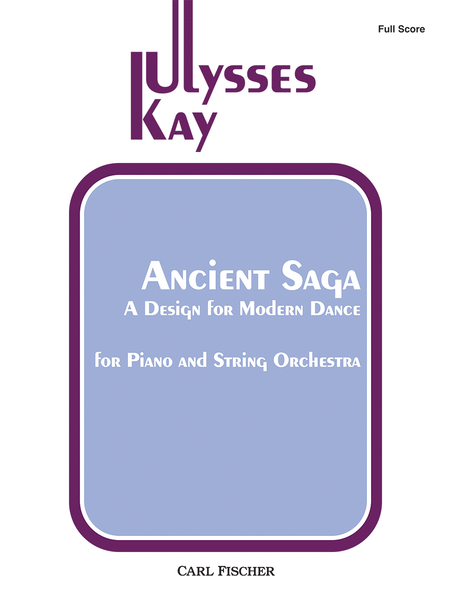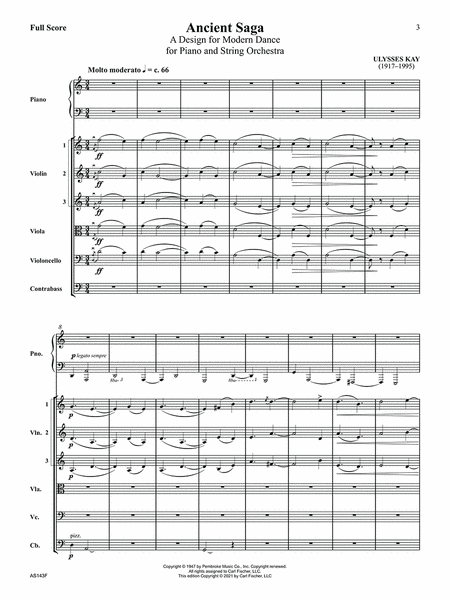Ancient Saga
A Design for Modern Dance
-
Ships in 1 to 2 weeks
Details
Description
SKU: CF.AS143F
A Design for Modern Dance. Composed by Ulysses Kay. Full score. 20 pages. Duration 8 minutes. Pembroke Music Co. #AS143F. Published by Pembroke Music Co. (CF.AS143F).ISBN 9781491155264. UPC: 680160913831.
Ulysses Kay was a prolific composer, whose catalog comprises a wide variety of works, including five operas, twenty large works for orchestra, numerous pieces for varied vocal forces and chamber works. His early training was auspicious, working with such distinguished pedagogues as William Grant Still, Howard Hanson, Paul Hindemith and Bernard Rogers. His music received attention and acclaim when the composer was only in his twenties. His numerous honors and awards in his early years include a Guggenheim Fellowship, an American Prix de Rome prize and a Fulbright Scholarship for studies in Europe. Later in his career he was awarded honorary doctorates from Lincoln College, Bucknell University, the University of Arizona and Illinois Wesleyan University. Kay favored neoclassical tendencies in his works, featuring lyricism, contrapuntal textures, clear formal designs and a tonal, yet chromatic harmonic vocabulary, all of which are evident in his Ancient Saga from 1947. The piece was originally composed as The Rope: A Design for Dance (After William Blake) for a solo dancer and piano in 1946 to fulfill a commission by Eleanor Goff, a longtime member of the Martha Graham Dance Company. Kay expanded the piece in the following year for piano and string orchestra: He would retain the reference to dance (although adding the qualifier "modern"), yet would remove the reference to William Blake. In Ancient Saga, the piano becomes both a solo instrument (retaining some of the writing from The Rope) and a harmonic-bass foundation, as in the opening forty-four measures of the work. Kay had a fine ear for string sonorities and clearly delighted in writing for an orchestra of strings, as evidenced in such works as String Triptych, Suite for Strings, Six Dances for String Orchestra and Pieta for English Horn and Strings. His appreciation of the poetry of William Blake can be found in subsequent works that set Blake's poetry to music, for example, Three Pieces after William Blake for Soprano and Orchestra from 1952 and the Triptych on Texts of William Blake from 1962.
Ulysses Kay was a prolific composer, whose catalog comprises a wide variety of works, including five operas, twenty large works for orchestra, numerous pieces for varied vocal forces and chamber works. His early training was auspicious, working with such distinguished pedagogues as William Grant Still, Howard Hanson, Paul Hindemith and Bernard Rogers. His music received attention and acclaim when the composer was only in his twenties. His numerous honors and awards in his early years include a Guggenheim Fellowship, an American Prix de Rome prize and a Fulbright Scholarship for studies in Europe. Later in his career he was awarded honorary doctorates from Lincoln College, Bucknell University, the University of Arizona and Illinois Wesleyan University.Kay favored neoclassical tendencies in his works, featuring lyricism, contrapuntal textures, clear formal designs and a tonal, yet chromatic harmonic vocabulary, all of which are evident in his Ancient Saga from 1947. The piece was originally composed as The Rope: A Design for Dance (After William Blake) for a solo dancer and piano in 1946 to fulfill a commission by Eleanor Goff, a longtime member of the Martha Graham Dance Company. Kay expanded the piece in the following year for piano and string orchestra: He would retain the reference to dance (although adding the qualifier “modern”), yet would remove the reference to William Blake. In Ancient Saga, the piano becomes both a solo instrument (retaining some of the writing from The Rope) and a harmonic-bass foundation, as in the opening forty-four measures of the work.Kay had a fine ear for string sonorities and clearly delighted in writing for an orchestra of strings, as evidenced in such works as String Triptych, Suite for Strings, Six Dances for String Orchestra and Pietà for English Horn and Strings. His appreciation of the poetry of William Blake can be found in subsequent works that set Blake’s poetry to music, for example, Three Pieces after William Blake for Soprano and Orchestra from 1952 and the Triptych on Texts of William Blake from 1962.


 Share
Share